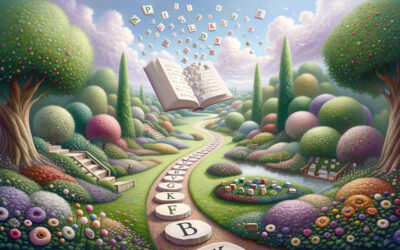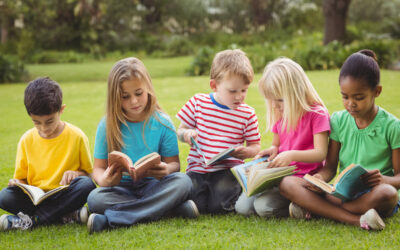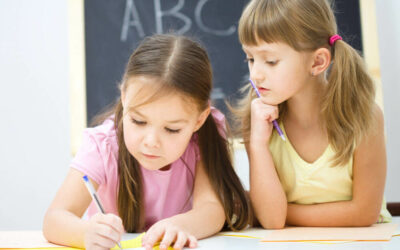How to Teach a 6 Year-Old to Read Successfully
Teaching a 6 year-old to read is one of the most important things you can do as a parent. It can affect their chances of employment, performance in school, and even their ability to live a happy life.
However, teaching them to read isn’t always easy. With so many different opinions being thrown around, it’s even harder to know where to begin.
That’s where this article comes in!
We’ll show you step by step how to teach your 6 year old to read and why doing so is so important.

Best Rated
See the Best Rated Reading Program
Take Quiz
Discover the ideal reading program for you & your child
Read this article
Continue reading the article
Should my 6 year-old be
At the age of 6, most children are in grade 1. They are working on mastering basic , including short vowel words and .
If they’re still in , they will be .
So while they may not be fluently at 6 years old, they should have a basic foundation in place.
Why it’s essential for 6-year-old kids to learn how to read.
The benefits
- is fun and can be a lifelong hobby
- Assists in brain development
- Helps them improve their ability to learn as they get older
- Kids who know how to read proficiently often go on to do well in life
- Improves their academic performance
- Helps them with their language skills and allow them to be more fulfilled as a person as they become older
Because 6 year-olds are very impressionable, it’s critical to make sure they’re exposed to a wide range of topics and materials.
Making time for teaching your how to read should be a priority!
My 6 year-old is a
While kids progress in at their own pace, many reasons may explain why some 6 year-olds struggle to read.
Children may struggle with because they:
- haven’t received sufficient pre- development
- may have hearing difficulties
- disabilities, or other developmental challenges such as that are affecting their ability to read
- they just need a bit more time and practice before they improve
If you suspect your is struggling with , consider asking the school for screening by the department. If your does have issues with , it’s important to get help early to learn how to overcome them and enjoy for life.
Tips on teaching your 6 year old to read
Before we get into the actual steps of teaching your to read, it’s crucial for you as the parent to always:
- Remain patient
- Display high energy
- Be consistent
This is important because the best way to teach kids something is by showing them you believe in their ability. If they see your attitude change when it comes time to help them with , they will be less likely to want to learn.
It’s also vital to pick the right time and place to teach them. You don’t want distractions such as the television, other children, or music playing in the background. It needs to be a quiet, distraction-free zone so your can fully focus on what you’re teaching them.
Focus on and Phonics
is the foundation of all . It’s something you should start with when you’re trying to teach a 6-year-old how to read or helping them overcome struggles.
is the ability to hear and tell the difference between different sounds in words.
The first step to is helping your develop an ear for the sounds that each letter makes.
Phonics is another crucial skill that can be taught at any age but is vital for children in grade 1 and up.
Phonics is the link between sounds, letters, and words. The purpose of phonics is to help children understand how letters represent different speech sounds in words. They do this by associating the sounds with particular letters to form words.
Phonics also helps kids learn to blend or combine into whole words and decode words into individual . For example, “cat” is broken down into /c/ /a/ /t/.
and phonics requires explicit instruction, so give your fun and formal phonics-based lessons every day at home. This will help them build a strong base for future .
Don’t worry; if you don’t know where or how to teach and phonics, keep because we have an excellent recommendation later in this article.
The tips we will now discuss are also important and should assist in:
- developing your ‘s vocabulary
- increasing their love for
- and improving general
Build-up Sight Word Knowledge
are high-frequency words seen most often in and common words that can’t be sounded out.
It’s best to start with just a few , ensuring that your has memorized them before moving on to new ones.
Read with Your
Studies show that children who enjoy in early grades are more likely to perform well in school.
But this doesn’t always happen without help!
That’s why you must read with your every day! We know it’s hard to find the time, but the bond you’ll build is priceless.
to children is an excellent way to open their minds to new concepts, expand their imagination, and help them grow.
To ensure your is at a high level, they should be for at least 10 – 20 minutes per day. You can’t expect them to absorb everything they read in one sitting, so making sure they’re throughout the day will ensure they’re new vocabulary and making connections with the text.
Many children struggle with , but aloud with your can help them understand what they are .
Make fun for them – don’t force it. aloud should be something you do for enjoyment and not punishment.
If they aren’t in the mood to read, you can always take a break and try again later.
The more you read to your , the more they are likely to read on their own
Read one page aloud to your with him following along, then have him read the next page. You can even read some pages together as well!
Keeping your ‘s attention can be difficult when they aren’t interested in the topic at hand.
To help ensure your continues with their daily sessions over time without losing interest early on, make sure you read books about subjects they enjoy instead!
At 6 years old, your is old enough to choose their own books. So tap into their interests and let them pick out the books they want to read. If they enjoy what they’re about – then it will all come that much easier.
Discuss the stories and ask questions
Discuss interesting words and points of interest, and think about how your feels about the . This encourages your to pay more attention to the story and build listening skills. This also shows them that is a social activity, where you can discuss what you are thinking.
Ask questions
When you read books to your , they must be engaged in the story. One way of doing this is by asking questions.
For instance, if a about a lost dog, you could use that as a call to action for them to try and read some words. Ask questions like “can you find a word with an ‘o’ in it?” or “do you think the dog’s name had an ‘e’ in it?” or “what do you think the dog’s owner’s last name was?”
You can also ask more advanced questions.
For example, if you read a with animals, ask them what they think of certain animals and how the animals might be feeling. Questions that encourage your to give more detail in their answers will help build their speaking and writing skills.
Make a game out of predicting what will happen in the story. Start by asking your , “What do you think might happen?” or “Why did character X make that choice?”. Then discuss their thoughts with them as we go along to see if those predictions came true at the end!
This is an engaging way to build and vocabulary.
Play
can help your develop their vocabulary and spelling skills.
Spelling words
Play a game where you spell out different words, like the name of an animal or object in the room. For example, if you’re about cats, say “C-A-T” and give them time to guess what word it is before telling them the answer. This game could also be played with objects in your ‘s environment, like their toys or items in a room.
Spell out letters
Spell out different letters throughout the and ask questions like “Can you find an ‘H’? Where is it?” or “Does this sentence start with an ‘A’? What letter is next to it?”. This game can also be played with sounds, like the sound that an animal makes.
I-Spy
A fun word game to play in the car is I-spy. For example, if they look out the window at birds in a tree, you could say, “I spy something that is brown” or “I spy something with 4 legs.” Or you could say, “I spy with my little eye something that starts with ‘S'” and see if they can guess what it is.
There are dozens of other fun you can play with your to help them build confidence and .
What is the best way for parents who don’t know how to teach their children to read?
Invest in a step-by-step phonics-based program.
We recommend the Children program. It’s one of the best reading programs for 1st graders that teaches a to read using a step-by-step approach.
The program is a very thorough and complete way to teach your how to read, as it covers all the necessary components of building a solid foundation.
It’s also designed for parents with no prior teaching experience. The program walks you through each lesson, so it’s incredibly easy to teach your .
It only requires a 10-minute commitment per day, which is why it’s also the best program for busy parents.
You can click the button below to learn more about the program or read our full review of Children .
is a skill that takes time to develop, so practicing often is essential. Your may not want to read at first, but by being patient and having fun along the way, they will learn to love it!
Like any skill, it takes time and effort to learn how to read. The most important thing to remember is that practice makes perfect. The more you practice with your , the faster they will learn.
is a life-long skill. Your will continue to use their the rest of their life, whether it’s street signs, restaurant menus, or newspapers.
Not only will help your learn, but it will also build their confidence. They will feel more confident when it’s time for them to read aloud in class or when they have to answer a question in front of a group.
The early years are a crucial time to teach a how to read.
At the age of 6, your is at a vital stage in their language development. They have a lot of new skills to learn, including how to read.
It is a big job to take on, but you can help transform your into a successful with the steps discussed above.
Fun Unleashed: ABC Recognition Games That Kids Love
Fun Unleashed: ABC Recognition Games That Kids LoveUnderstanding the monumental role early...
Unlocking ABCs: The 5 Best Apps for Learning the Alphabet
Unlocking ABCs: The 5 Best Apps for Learning the AlphabetIn today's fast-paced digital world, the...
How to Help Students with Reading Comprehension: A Parent’s Guide to Success
How to Help Students with Reading Comprehension: A Parent's Guide to SuccessAs a guiding light for...
What is Skilled Reading: A Comprehensive Guide for Parents
What is Skilled Reading: A Comprehensive Guide for ParentsImagine a world where every child reads...
How to Learn the Phonetic Alphabet
How to Learn the Phonetic AlphabetAs parents, we all dream of the moment our child reads their...
Learning the Alphabet and Sounds: A Comprehensive Guide to Early Literacy Skills
Learning the Alphabet and Sounds: A Comprehensive Guide to Early Literacy SkillsDiving into the...
The Importance of Learning the Alphabet: Laying the Foundation for Reading Success
The Importance of Learning the Alphabet: Laying the Foundation for Reading SuccessWhen we think...
High Frequency Words vs Sight Words in Early Reading: Unlocking the Puzzle
High Frequency Words vs Sight Words in Early Reading: Unlocking the PuzzleAh, the tender journey...
Words for Kindergarten to Learn: Unlocking a World of Communication and Discovery
Words for Kindergarten to Learn: Unlocking a World of Communication and DiscoveryEmbarking on the...
How to Help Kindergarteners Learn Sight Words: A Journey of Discovery and Mastery
How to Help Kindergarteners Learn Sight Words: A Journey of Discovery and MasteryEmbarking on the...
Learning the Letters in Your Name: Unlocking the First Door to Literacy
Learning the Letters in Your Name: Unlocking the First Door to LiteracyOh, the delightful spark in...
Alphabet Letters in Order with Numbers for Your Little Learner
Alphabet Letters in Order with Numbers for Your Little LearnerEmbark on a delightful journey where...
Teaching ABCs to Preschoolers: Embarking on an Alphabet Adventure
A Guide to Teaching ABCs to Preschoolers: Embarking on an Alphabet AdventureEmbarking on the...
The Best Way to Teach Letter Recognition: Laying the Alphabetical Foundation
The Best Way to Teach Letter Recognition: Laying the Alphabetical FoundationEvery child's journey...
Phonemic Awareness vs Letter-Sound Correspondence: Unlocking The Mysteries of Early Literacy
Phonemic Awareness vs Letter-Sound Correspondence: Unlocking The Mysteries of Early Literacy...
How to Use Elkonin Sound Boxes for Phonics
What is Decoding in Phonics: Unlocking the Secrets of Early Literacy "Sound boxes for...
What is Decoding in Phonics: Unlocking the Secrets of Early Literacy
What is Decoding in Phonics: Unlocking the Secrets of Early Literacy Have you ever watched...
How to Teach the Difference between B and D: The Best Ways to Stop Letter Reversals
How to Teach the Difference between B and D: The Best Ways to Stop Letter Reversals Are you...
What Are Graphemes and Phonemes? The Difference Between Graphemes and Phonemes
What Are Graphemes and Phonemes? The Difference Between Graphemes and Phonemes ...
How Does Reading Help the Brain? A Guide for Parents
How Does Reading Help the Brain? The Ultimate Reading Guide for Parents Welcome to an...

Natalie is a full-time blogger and former elementary school teacher who specializes in helping parents teach their kids to read. With a qualification in Early Childhood Education, over 7 years of experience in education, and a passion for literacy, Natalie provides practical tips, activities, and resources for parents looking to support their child’s learning-to-read journey. She is the proud mom of two young readers and loves sharing her knowledge and experience with other parents. Natalie enjoys spending time with her family, reading, and exploring the great outdoors when she’s not blogging.




































